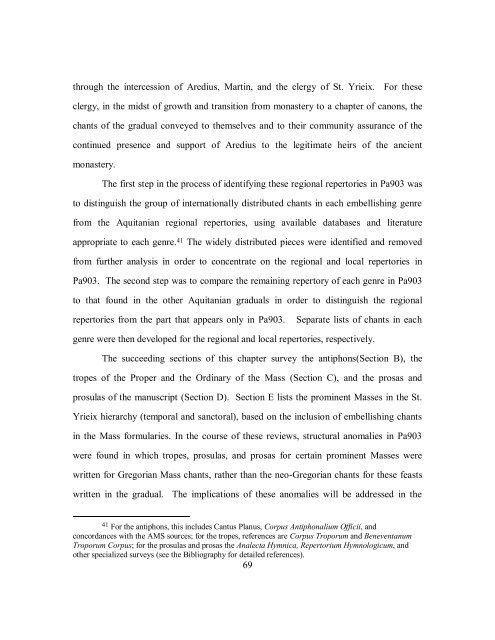Front Matter Template - The University of Texas at Austin
Front Matter Template - The University of Texas at Austin
Front Matter Template - The University of Texas at Austin
Create successful ePaper yourself
Turn your PDF publications into a flip-book with our unique Google optimized e-Paper software.
through the intercession <strong>of</strong> Aredius, Martin, and the clergy <strong>of</strong> St. Yrieix. For these<br />
clergy, in the midst <strong>of</strong> growth and transition from monastery to a chapter <strong>of</strong> canons, the<br />
chants <strong>of</strong> the gradual conveyed to themselves and to their community assurance <strong>of</strong> the<br />
continued presence and support <strong>of</strong> Aredius to the legitim<strong>at</strong>e heirs <strong>of</strong> the ancient<br />
monastery.<br />
<strong>The</strong> first step in the process <strong>of</strong> identifying these regional repertories in Pa903 was<br />
to distinguish the group <strong>of</strong> intern<strong>at</strong>ionally distributed chants in each embellishing genre<br />
from the Aquitanian regional repertories, using available d<strong>at</strong>abases and liter<strong>at</strong>ure<br />
appropri<strong>at</strong>e to each genre. 41 <strong>The</strong> widely distributed pieces were identified and removed<br />
from further analysis in order to concentr<strong>at</strong>e on the regional and local repertories in<br />
Pa903. <strong>The</strong> second step was to compare the remaining repertory <strong>of</strong> each genre in Pa903<br />
to th<strong>at</strong> found in the other Aquitanian graduals in order to distinguish the regional<br />
repertories from the part th<strong>at</strong> appears only in Pa903. Separ<strong>at</strong>e lists <strong>of</strong> chants in each<br />
genre were then developed for the regional and local repertories, respectively.<br />
<strong>The</strong> succeeding sections <strong>of</strong> this chapter survey the antiphons(Section B), the<br />
tropes <strong>of</strong> the Proper and the Ordinary <strong>of</strong> the Mass (Section C), and the prosas and<br />
prosulas <strong>of</strong> the manuscript (Section D). Section E lists the prominent Masses in the St.<br />
Yrieix hierarchy (temporal and sanctoral), based on the inclusion <strong>of</strong> embellishing chants<br />
in the Mass formularies. In the course <strong>of</strong> these reviews, structural anomalies in Pa903<br />
were found in which tropes, prosulas, and prosas for certain prominent Masses were<br />
written for Gregorian Mass chants, r<strong>at</strong>her than the neo-Gregorian chants for these feasts<br />
written in the gradual. <strong>The</strong> implic<strong>at</strong>ions <strong>of</strong> these anomalies will be addressed in the<br />
41 For the antiphons, this includes Cantus Planus, Corpus Antiphonalium Officii, and<br />
concordances with the AMS sources; for the tropes, references are Corpus Troporum and Beneventanum<br />
Troporum Corpus; for the prosulas and prosas the Analecta Hymnica, Repertorium Hymnologicum, and<br />
other specialized surveys (see the Bibliography for detailed references).<br />
69

















